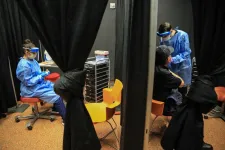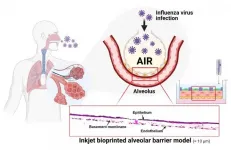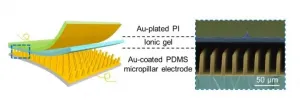(Press-News.org) The alarm bells began ringing when dozens of eagles were found dead near an Arkansas lake.
Their deaths--and, later, the deaths of other waterfowl, amphibians and fish--were the result of a neurological disease that caused holes to form in the white matter of their brains. Field and laboratory research over nearly three decades has established the primary clues needed to solve this wildlife mystery: Eagle and waterfowl deaths occur in late fall and winter within reservoirs with excess invasive aquatic weeds, and birds can die within five days after arrival.
But until recently, the toxin that caused the disease, vacuolar myelinopathy, was unknown.
Now, after years spent identifying a new toxic blue-green algal (cyanobacteria) species and isolating the toxic compound, an interdisciplinary research group from the University of Georgia and international collaborators have confirmed the structure of this toxin. The results were recently published in the journal Science.
The cyanobacteria grows on the leaves of an invasive water plant, Hydrilla verticillata, under specific conditions: in manmade lakes when bromide is present. The bacteria--and animal deaths from the disease it causes--has been documented in watersheds across the southeastern United States. This is why it's important for anyone in the outdoors--anglers, hunters, birdwatchers and more--to be aware of the signs of this neurological infection and avoid consuming infected animals.
"We want people to recognize it before taking birds or fish from these lakes," said Susan Wilde, an associate professor of aquatic science at the Warnell School of Forestry and Natural Resources who first discovered the cyanobacteria. In some animals, such as birds, turtles, salamanders and even a beaver, the disease manifests as erratic movements or convulsions. Anglers must be even more cautious, though, as it's impossible to detect toxin in fish without obvious symptoms.
"For fish, it's tough. I would avoid eating fish with lesions or some sort of deformities; we do see affected fish with slow swimming speeds, but anglers won't be able to see that," added Wilde. "We want people to know the lakes where this disease has been documented and to use caution in consuming birds and fish from these lakes."
Wilde and Warnell graduate students studying the cyanobacteria have compiled maps and a list of affected watersheds.
The most recent study details new mapping of the bacteria's genome, a final piece in the puzzle to understand how it develops and survives. Wilde and others have been studying the cyanobacteria since 2001, when bald eagles began dying in Georgia, South Carolina and North Carolina. The following decades saw the discovery of the cyanobacteria itself, Aetokthonos hydrillicola (Latin for "eagle killer that grows on Hydrilla"), and connections made between the invasive aquatic plant and the animals that eat it.
But until recently, said professor Timo Niedermeyer of the Institute of Pharmacy at Martin Luther University Halle-Wittenberg in Germany, the origin of the brain-decimating disease was a mystery.
Niedermeyer, who has worked with cyanobacteria natural products for years, wanted to help put the pieces together. He contacted Wilde and offered to collaborate. Samples of Hydrilla collected in the field were sent to him, and his lab cultivated the cyanobacteria in the laboratory and sent them back to UGA for further testing. But the tests came back negative: The cyanobacteria from the lab did not induce the disease.
"It's not just the birds that were going crazy, we were too. We wanted to figure this out," said Niedermeyer. Once again, he had colonized leaves sent to him from UGA.
Steffen Breinlinger, a doctoral student in his research group, then used a new imaging mass spectrometer to investigate the composition on the surface of the plant's leaf, molecule by molecule. He discovered a new substance that only occurs on the leaves where the cyanobacteria grows but is not produced in the cyanobacteria cultures. His investigations into the chemical structure of the isolated molecule revealed five bromine atoms.
"The structure is really spectacular," said Breinlinger. The properties are unusual for a molecule formed by cyanobacteria, and they provide an explanation for why the toxin did not form under laboratory conditions, where bromide isn't present. "We then added bromide to our lab cultures, and the cyanobacteria started producing the toxin."
After almost a decade of testing the isolated molecule and collaboration between the labs in Germany and Georgia, they had their proof: the molecule does trigger vacuolar myelinopathy. The researchers call their discovery aetokthonotoxin, "poison that kills the eagle."
"Finally, we did not only catch the murderer, but we also identified the weapon the cyanobacteria used to kill those eagles," said Wilde.
The neurological disease has not yet occurred in Europe, and no instance of the toxin-forming cyanobacterium has been reported. Humans are not yet known to be affected by vacuolar myelinopathy, although the study did successfully affect chickens with the toxin, and Wilde continues to test fish and waterfowl such as ducks and coots for the disease.
INFORMATION:
PITTSBURGH, March 26, 2021 - As evidence mounts supporting the use of monoclonal antibody treatment to reduce hospitalizations and deaths from COVID-19, UPMC and University of Pittsburgh School of Medicine physician-scientists are sharing the health system's experience administering the life-saving medication.
In a report published today in the scientific journal Open Forum Infectious Diseases, the UPMC/Pitt team shares how it quickly established the largest and most equitable distribution network for COVID-19 monoclonal antibody infusions across Pennsylvania. The team today also reported preliminary results confirming the treatment reduced likelihood of hospitalization ...
EL PASO, Texas - Sreenath Chalil Madathil, Ph.D., assistant professor in industrial manufacturing and systems engineering (IMSE) at The University of Texas at El Paso, is working to streamline the process and ease the patient experience at COVID-19 vaccination clinics in the United States to ensure faster vaccine distribution.
Madathil led a team of UTEP faculty, staff and students who observed several of El Paso's drive-though and walk-in clinics in early 2021. The team identified areas that likely created bottlenecks, which produce delays and other issues. They used the information ...
A University of Florida study of middle-aged and older adults finds those who unknowingly carry methicillin-resistant Staphylococcus aureus, or MRSA, on their skin are twice as likely to die within the next decade as people who do not have the bacteria.
"Very few people who carry MRSA know they have it, yet we have found a distinct link between people with undetected MRSA and premature death," said the study's lead author Arch G. Mainous III, Ph.D., a professor in the department of health services research, management and policy at the UF College of Public Health and Health Professions, part of UF Health, the university's academic health center.
The findings suggest that routine screening for undetected ...
The warmer temperature and blooming flowers signal the arrival of spring. However, worries about respiratory diseases are also on the rise due to fine dust and viruses. The lung, which is vital to breathing, is rather challenging to create artificially for experimental use due to its complex structure and thinness. Recently, a POSTECH research team has succeeded in producing an artificial lung model using 3D printing.
Professor Sungjune Jung of the Department of Materials Science and Engineering, and Professor Joo-Yeon Yoo and Ph.D. candidate Dayoon Kang of the Department of Life Sciences at POSTECH have together succeeded in creating ...
Key takeaways
Surgery is an underused treatment for certain pancreatic cancer patients.
Patients with pancreatic cancer who underwent surgery after chemotherapy lived nearly twice as long as those treated with only chemotherapy.
Findings confirms current recommendations for stage II pancreatic cancer: survival improves when patients receive multimodality therapy, chemotherapy before and/or after surgery.
All analyses of the data delivered the same findings.
CHICAGO (March 26, 2021, 9:00 am CDT): Patients with stage II pancreatic cancer who are treated with chemotherapy followed by resection (an operation that removes the cancerous part of the organ, structure or tissue) live nearly twice as long as patients who receive only chemotherapy, according ...
In recent years, with the rapid development of flexible electronic skins, high-performance flexible tactile sensors have received more attention and have been used in many fields such as artificial intelligence, health monitoring, human-computer interaction, and wearable devices. Among various sensors, flexible capacitive tactile sensors have the advantages of high sensitivity, low energy consumption, fast response, and simple structure. Sensitivity is an important parameter of the sensor. A common way to improve sensitivity is to introduce microstructures and use ionic dielectric materials at the interface ...
A new catalyst for the conversion of carbon dioxide (CO2) into chemicals or fuels has been developed by researchers at Ruhr-Universität Bochum and the University of Duisburg-Essen. They optimized already available copper catalysts to improve their selectivity and long-term stability. The results are described by the team led by Dr. Yanfang Song and Professor Wolfgang Schuhmann of the Bochum Center for Electrochemistry with the team led by Professor Corina Andronescu of the Duisburg-Essen Technical Chemistry III group in the journal Angewandte Chemie, published online on 9 February 2021.
Boron makes copper catalyst stable
The ...
Current approaches to a common and debilitating knee injury that occurs more frequently for women than men have focused for too long on biology at the expense of understanding social factors, say the authors of a new paper in the British Journal of Sports Medicine (BJSM).
Girls and women are said to be between three to six times more likely to suffer an anterior cruciate ligament (ACL) injury, where one of the key ligaments that helps to stabilise the knee joint is damaged. The devastating injury, which in extreme cases can be career ending for professional sportspeople, commonly occurs during sports that involve sudden changes in direction (e.g. basketball, football ...
When the brain suffers injury or infection, glial cells surrounding the affected site act to preserve the brain's sensitive nerve cells and prevent excessive damage. A team of researchers from Charité - Universitätsmedizin Berlin have been able to demonstrate the important role played by the reorganization of the structural and membrane elements of glial cells. The researchers' findings, which have been published in Nature Communications*, shed light on a new neuroprotective mechanism which the brain could use to actively control damage following neurological injury or disease.
The nervous system lacks the ability to regenerate nerve cells and is therefore particularly vulnerable to injury. Following brain injury or infection, various cells ...
An elusive whale species in the Southern Ocean could be resilient to near-future ecosystem changes, according to a new study by the universities of Exeter and Copenhagen.
Gray's beaked whales living in the deep oceans of the Southern Hemisphere are rarely seen alive and their ecology has remained a mystery to scientists until now.
The study used genome sequencing of 22 whales washed up on beaches in South Africa, Australia and New Zealand to investigate the history of the population over the past 1.1 million years.
Author of the study Dr Kirsten Thompson, of the University of Exeter, said: "The population approximately doubled about 250 thousand years ago, coinciding with a period of increased Southern Ocean productivity, sea surface temperature and a potential ...





